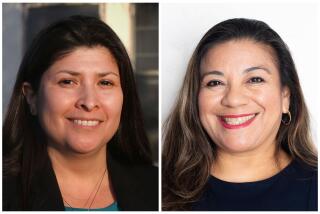Who’s Minding the Air at Your Child’s School?
- Share via
SANTA CRUZ — Both President George W. Bush and Gov. Gray Davis want schools to meet tougher standards, to be accountable to parents and to improve student performance. But enhancing education requires going beyond the basics of testing, teacher training and curriculum reform. A study we conducted in the Los Angeles Unified School District suggests that a school’s environment can impair learning.
For a decade, researchers have raised concerns about the rise in learning disabilities among children in the U.S. Approximately 12 million children suffer from learning, developmental or behavioral problems; the number of students enrolled in special-education programs has increased nearly 200% over the last 20 years. Soaring rates of childhood asthma, especially among inner-city youth, have been linked to school absenteeism and diminished learning capacity. Increasingly, scientists and regulators see environmental pollution as a potential cause.
Many studies have investigated the short-term effects of dirty air--eye irritation, coughing and chest tightness--on the health of adults. New research suggests that polluted air may also have long-term adverse effects on kids. Researchers looking at the Los Angeles Basin, for example, recently concluded that air pollutants commonly found in smog can significantly impair lung growth and function in children.
Most studies on the health of children’s environments focus on conditions in their neighborhoods. Yet, children can also encounter hazards at their schools. True, a majority of students in Los Angeles live and attend school in the same neighborhoods, but a significant number of them cross town on an army of buses to attend magnet schools or simply because their neighborhood schools are overcrowded; many white middle-class students attend private schools far from their homes.
There have been dramatic examples of environmental hazards located near some Southern California schools. Many parents of students at Suva Elementary and Intermediate schools in Bell Gardens blamed chrome-plating plants nearby for a cluster of cancer cases among students and teachers. While health officials and researchers could not demonstrate a causal link, community and parental pressure forced clean-ups at the two sites. Last week, similar pressure forced the LAUSD to promise removal of arsenic-tainted soil at Park Avenue Elementary in Cudahy.
Cases like Suva and Park, where more than 95% of the students are Latino, have reinforced concerns that pollution and its effects may not be an equal-opportunity problem. If environmental risks are disproportionately concentrated at minority schools, and their effects spread beyond health to include student achievement, then they are another obstacle in the path of children who already face barriers of poverty, neighborhood instability and underperforming schools.
To explore these questions, we recently examined the distribution of potential environmental risks among schoolchildren in LAUSD. The local environmental conditions of each school was mapped. A school’s racial composition, test scores, teacher experience and other variables were determined so patterns could be revealed. The results were striking.
Using air-toxicity models developed by the Environmental Protection Agency, we estimated cancer and respiratory risks associated with pollution sources near each school. The fifth of the schools with the cleanest air were nearly 30% Anglo (in a school district that is less than 15% white), while the fifth with the most polluted air were 92% minority.
This disparity could simply be a function of other factors. For example, heavily minority schools tend to be located in older industrial areas. We therefore tried to control for factors usually associated with pollution: population density, the percentage of land zoned for industrial use, income levels and home ownership (often a sign of both political power and resident commitment to the neighborhood). Nevertheless, the racial make-up of the student body still played a significant role in predicting the environmental risks associated with a school.
Is this correlation simply a reflection of neighborhood demographics? After all, previous research indicates that Southern California’s most hazardous air pollutants, as well as its toxic storage and disposal facilities, are disproportionately concentrated in minority communities. To account for this, we reanalyzed our data to determine if a school was more or less minority than would have been predicted from the neighborhood in which it was situated. As it turns out the racial disparity persisted, with significantly higher cancer and respiratory risks from hazardous air pollutants in the schools with more minority students than would have been expected, given local demographics.
Do these persistent health disparities among Los Angeles schoolchildren have other effects? We examined the relationship between respiratory risks and school achievement, as measured by the Academic Performance Index. Even after accounting for the poverty levels of the students, their English language proficiency, the percentage of teachers with emergency credentials, the educations of parents and other standard predictors of academic achievement, air pollution had a negative and statistically significant effect on test scores.
The causal chain and biological mechanisms involved remain unclear, and detailed epidemiological work is necessary. But the apparent connection between pollution and impaired learning is troubling, given that many minority and low-income students already face academic challenges. Why put one more barrier in their way?
The LAUSD is slated to build 86 new schools in the next five years. With land scarce in the densely populated inner city, the district will have to consider areas once used for industrial uses. While tradeoffs may be necessary, the results of our study, coupled with the controversies generated by the sitings of the Belmont Learning Complex and a new South Gate high school, suggest that any proposed school location and construction plan take into account the vulnerability of children to environmental hazards.
When we see a pattern in which environmental hazards are disproportionately affecting minority children’s health and academic performance, we must ask: Who’s minding the kids?
More to Read
Sign up for Essential California
The most important California stories and recommendations in your inbox every morning.
You may occasionally receive promotional content from the Los Angeles Times.










